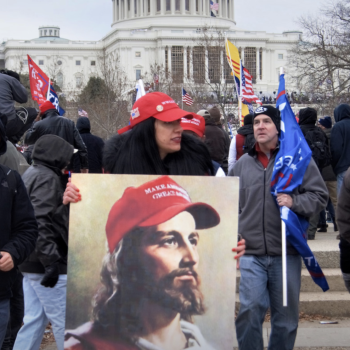It’s one of the blessings in my life that the authors of The Long Southern Strategy, Angie Maxwell and Todd Shield, are also my neighbors and friends. I appreciate Angie’s work not only in political analysis but also in community organizing, and Todd Shield’s leadership at the university, combined with Angie’s work in Southern Studies, contributes not just to the world of scholarship but to our shared community life together.
I may come to this book at a somewhat different perspective from other analysts. I read works in Southern Studies not as a native southerner but as a transplant to the region. I pastor in a denomination relatively new to Arkansas, and so am not of the traditions reflected in the book’s analysis. In fact, the first Southern Baptist church I ever encountered was a new mission start that was planted in my small town in Iowa in the late 80s.
This makes me in a sense a double-outsider, just familiar enough with one small slice of southern life (Northwest Arkansas) to be dangerous. As one of the jokes I learned when I moved here goes, “What’s the difference between a Yankee and Damn Yankee? A Damn Yankee stays.”
Well, I’ve stayed. So I’ve made a long-term commitment not only to experiencing the culture in which I now live, but also reading great books about it. Some of those that have especially offered a more nuanced view of the region, and for which I give thanks, include Arkansas/Arkansaw (Blevins), Hipbillies (Phillips), and The New Mind of the South. (Thompson)
Many of these address the culture of the region, but none helped me understand the unique developments of southern political life in the last half century in the kind of detail I’ve desired.
For that, we finally have this book.
I spent the first 35 years of my life mostly in the Midwest, a region of the country where party affiliation remained largely stable (even if the commitments of the parties shifted somewhat). I think I knew in the abstract that over a period of time Southern Democrats had slowly become Republican, but I don’t think I ever really understood why. I certainly didn’t understand with any kind of granular detail how it might have been related to a specific Republican strategy.
Nor have I ever been aware, prior to reading this book, the extent to which the Republican pursuit of a regional strategy effectually changed all of American politics as we know it.
I mean, I’ve watched with great perplexity over the course of my lifetime as the Iowa senator I grew up with, Chuck Grassley, veered further and further to the right. I wondered where the Republican Party of my grandfather went.
But The Long Southern Strategy, surprisingly, helped me understand the phenomenon better than any analysis of the Midwest has done, precisely because I simply had never quite taken account of how the Long Southern Strategy, though a southern strategy, has affected everything.
Right down to the experience I had in 2016, where I went home for the holidays in Des Moines, went on a run, and saw more Confederate flags flying in front yards than I had ever seen in Arkansas.
What Do You Need To Know About This Book?
This book is replete with data. So much data. If you are a data junkie, this is definitely the book for you. Even if you’re not a data junkie, and tend to skim charts and graphs, this book will convince you the authors have done their homework (and then some). Their analysis isn’t the subjective ponderings of political pundits, it’s based off real numbers.
Second, it is the basic thesis of this book that the Long Southern Strategy was not just a strategy related to race, although it was about that. Instead, the Long Southern Strategy functioned at the intersection of issues of race, gender, and religion.
As they point out early in the book, “What Earl and Merle Black called ‘The Great White Switch’ [of Southern Democrats to Republican] was actually ‘The Great, White, Anti-Feminist, Christian Switch.’ Absent an understanding of the role of southern white sexism in this realignment, racism and religiosity read as two chapters of separate books. They were and are an ensemble cast in the same story, better known as ‘The Long Southern Strategy.'” (9).
This ensemble cast relies on the constant stoking of the sense of threat. Threat to a way of life. Threat to Christianity. Threat to women. Threat to the supremacy of whiteness. It is inherent to the strategy that fear and rage must always play a role.
In this sense, as many pundits have mentioned, Donald Trump is the great Southern President.
Additionally whiteness, of all these categories, is the most pliable. “Politically malleable, whiteness has proven to be the GOP’s blank check that always clears” (12).
Religion, in the meantime, is not to so much pliable as ubiquitous, to such an extent that the “reach of some southern churches is so powerful that even nonbelievers in proximity receive their social cues indirectly” (16).
The strength of the book, the reason it is worth reading not simply for the thesis, but also the proof of the thesis, lies in its convincing argument that each of the three landmark shifts (the GOP’s strategies related to whiteness, anti-feminism, and religion) “did mark a new base camp on the path to Republican ascendancy in the South. But sometimes the whole–the multidimensional Long Southern Strategy–gets lost among the pieces (24).
Maxwell and Shield argue that Southern voters are in the end “way of life” voters rather than “rational-choice economic voters.” Thus a geographical locale where an alliance of workers would have been beneficial to many was squashed by the stronger notion of southern identity.
Just today I read an interview with Tom Cotton, who said, talking about the tariffs currently bankrupting farmers across our country: “Look at the sacrifices soldiers, sailors, airmen, and Marines make around the world, and they’re willing to bear some of the sacrifices in the short term, to hopefully in the long term ensure our long-term prosperity and security.”
The authors of The Long Southern Strategy point out that “poor southern whites have long been conditioned to forfeit a personal battle in the service of winning an imagined war from which they do not benefit” (35).
Finally, one fascinating thesis of the book is that the decision to chase “white southern voters in order to build a new Republican coalition was not only intentional, strategic, and effective, but it was also unabating. Over time, this repeated choice turned the Republican Party into a safe space for white racial anger, resentment, anxiety, and denial, much of which it promoted or even manufactured” (37).
Sound familiar?
So What About Southern Religion?
For those reading here in the progressive Christianity section of Patheos, you might wonder, “What is Southern Christianity?”
Sometimes I wonder the same thing. The present-day political maneuverings of southern Christianity perform a religion that seems to emphasize values, but many analysts, myself included, would agree with historian Samuel Hill’s assessment that southern Christianity “carefully sifts the biblical material and systematizes it into a series of truths around the central commission to save souls, tying it to evangelicalism in a common fight” (220).
As a midwestern Lutheran, I notice this often, because this form of Christianity defines the “gospel” quite different than my tradition. For them, the gospel is for the lost, a thing to dispense to save souls. For me, it’s about God’s righteousness and the healing of the world.
Such an emphasis on the saving of souls makes Christianity itself rather pliable. It offers a lot of space then to be apolitical or blindly political, at will. As the authors point out, such an abstract emphasis on saving of souls turns Christianity into a “lifestyle brand.” It’s something you can wear.
In the meantime, the fundamentalist occupation of the south’s largest denomination, Southern Baptists, exiled many, consolidated power for a radical few, which over time meant that “Trump was able to pass as a Christian in the first southern primary in South Carolina because Christianity is no longer a belief system. It is a culture that the GOP alliance with the Christian Right helped to create” (224).
It’s the myth of social conservatism that is the salient point is moral issues. “Rather, the Christian Right, of which southern whites were and are the primary use, expanded its vision beyond such debates into policy battles over the environment, the economy, and immigration, to name a few. There is a new militancy to the vision, whereby every issue becomes part of the evangelical cosmology in a spirit of Christian nationalism that has long been a part of the southern white mind” (224).
The authors point out that “the transformation of evangelical fundamentalists from politically inactive to a 66 percent self-reported turnout rate in 1984 remains one of the most radical shifts in modern American politics” (262). Overall, the analysis emphasizes this shift is related to whiteness, rurality, and lower incomes, as well as regionalism, as defining characteristic of this shift.
Barry Goldwater warned of this. “Mark my word… if and when these preachers get control of the [Republican] party, and they’re sure trying to do so, it’s going to be a terrible damn problem. Frankly, these people frighten me. Politics and governing demand compromise” (286).
I can see the concern. From Mike Huckabee, to the generally religious overtones of so many of the Republicans with which I have to contend, I honestly wish they were quite a bit less beholden to their preachers and the ideology.
Late in the book, the authors point out the extent to which it was Billy Graham and his crusades that influenced the direction not only of the Republican Party (for whom he was a regular high level consultant and counselor) but as a result our nation as a whole.
“The addition of ‘In God We Trust’ on US currency and ‘Under God’ into the Pledge of Allegiance under President Eisenhower’s tenure occurred right after Reverend Billy Graham ‘went to Washington and made Congress his congregation'” (306).
And most fascinating, something from which the current progressive denominations are (admittedly tardily) learning. “The denominational unity necessary to build a sustainable and influential movement required evangelicals and fundamentalists to focus on their shared Christian culture, rather than their theological differences with fellow Protestants, and later with Catholics too, among others. Faith became ideology and ideology became faith. ‘Conservative Christians are the grassroots,’ leaders of the religious media reasoned, must ‘simply organize themselves according to their politics rather than their particular denominations.’ And organize they did. Southern white fundamentalism insisted on its reactionary righteousness, asserting its power to shape debates over public policy nationwide” (317).
The Long Southern Strategy is an essential, informed study of the strategy that has brought not only the South, but our nation as a whole, to the place we now find ourselves. It is just so an essential, informed study in how we might begin to imagine an alternative to the present as we strategize for the future.
—
So, Maxwell said, “Simply put, on one side of this fight are those championing what is the original essence of the Baptist faith—individual religious liberty—who are, in many ways, the spiritual descendants of those Baptists moderates exiled from the SBC so many years ago. On the other side are evangelical, fundamentalist, highly politicized Baptists who advocate for the establishment of a national religion—their religion.”












